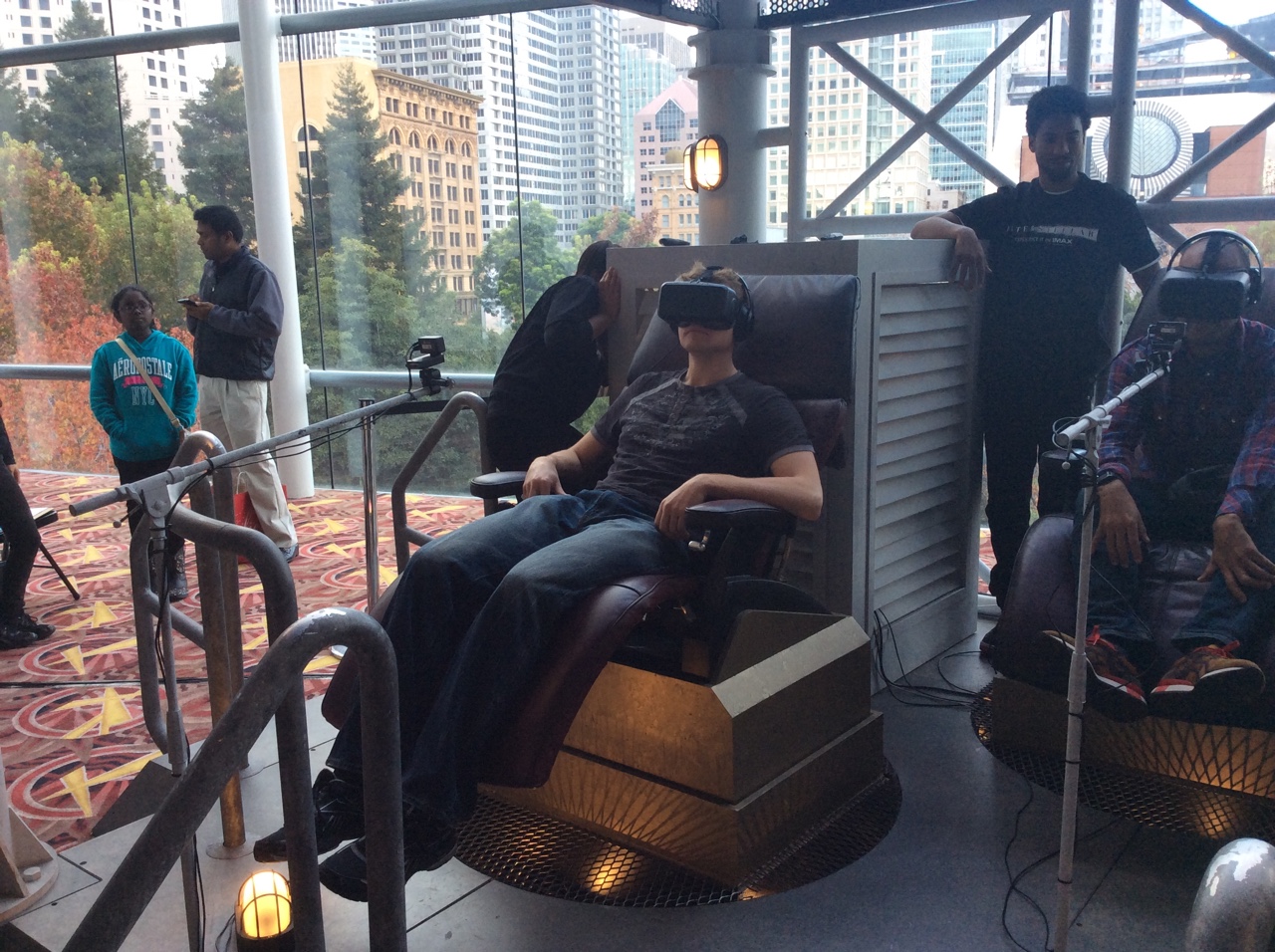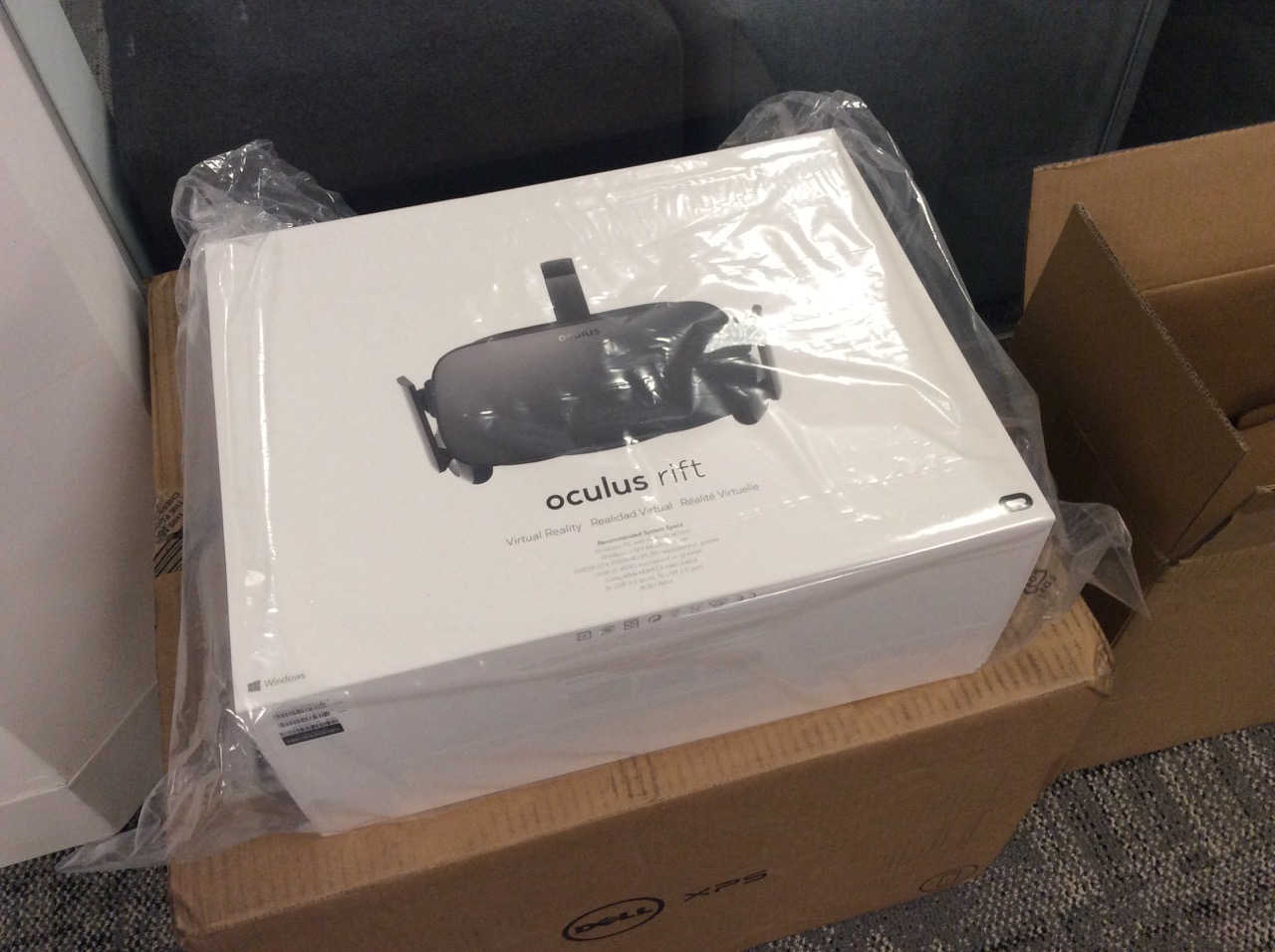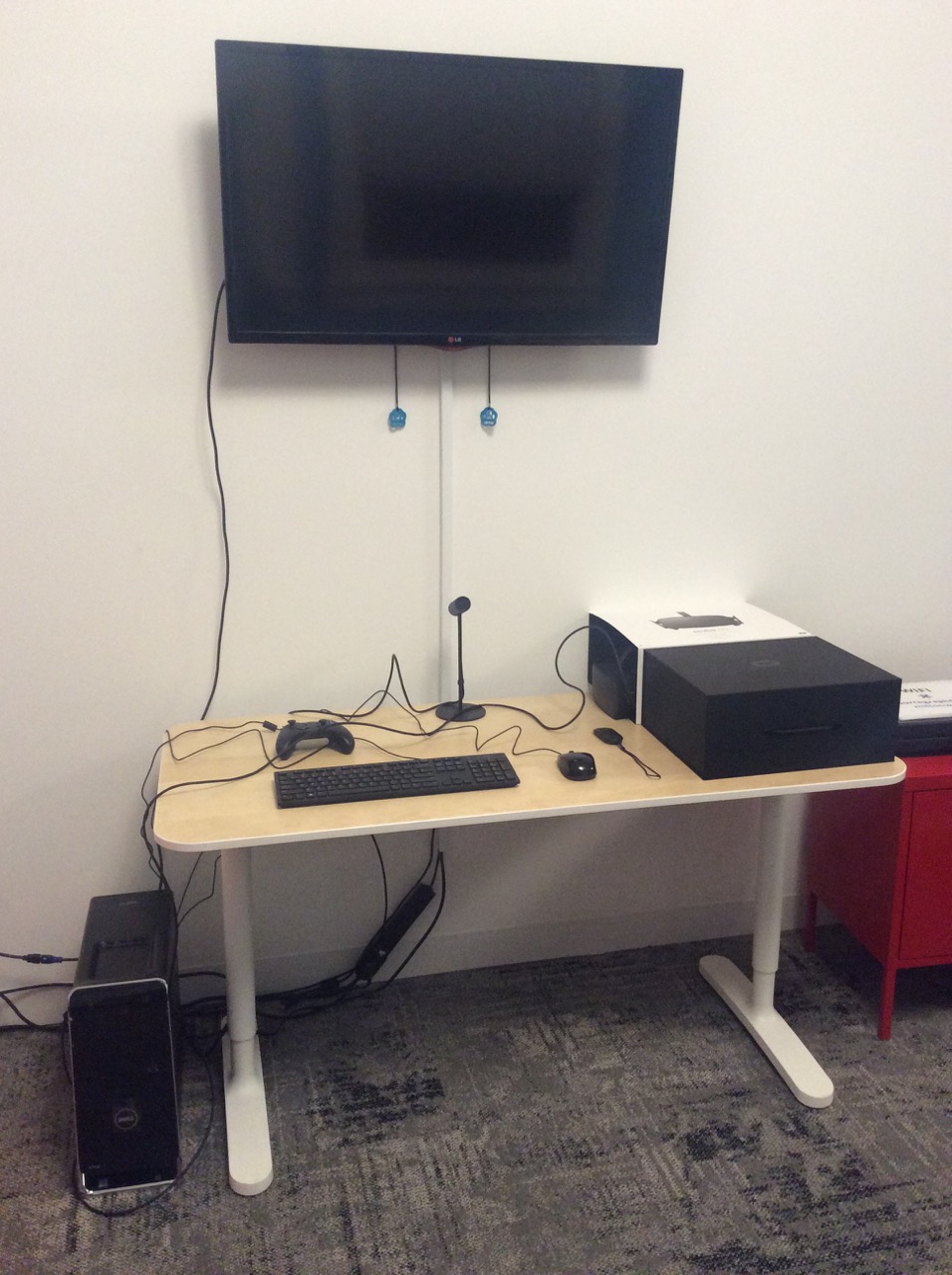Trying out the Oculus Rift CV1 for the first time
Last night I got a chance to setup and spend a few hours with the long-awaited first consumer version of the Oculus Rift (aka Oculus Rift CV1). I'll describe my experience in some detail.
Background
This is not my first time trying on a VR headset. I've tried the first developer kit (DK1) a long time ago, but only for a few minutes. It was compelling enough to make me understand that the final release, scheduled a few years off at the time, would be incredible, but of course there were a few "must fix this and must make that better first" items remaining. I had to use my imagination to predict what it'd feel like in the end. I tried two experiences: a pretty basic unexciting demo of pong in 3D, and a virtual walkthrough through Japan in the form of a 360 video. The latter was great for making me feel the presence factor and ability to experience an exotic real-world location.
Some time later, I tried the second dev kit (DK2) with a pretty sweet experience. There was a demo booth at a movie theater that was playing Interstellar, and they had a 5-8 minute Interstellar-themed experience. You sat in a nice, comfy chair, they put on the DK2 and a pair of high-quality headphones, and you were transported into a situation on board of a futuristic spaceship. It was a high-budget demo, so the 3D environment was professionally made with lots of detail. You could look around, and primarily, you could feel the sense of presence... Actually being in that spaceship, and exploring what it had to offer. My favorite parts were the section where they made you feel weightlessness. With a countdown from 3, the experience creators used a combination of motion, a "whoosh" sound, and the chair you were sitting in slightly dropping down, to very convincingly make you feel that suddenly gravity was turned off. The other part I loved was the end, where you got to a very detailed cockpit of the spaceship, complete with many controls, buttons, joysticks. When you looked out the windows, you could see some planet in the nearby distance...
Initial setup
Ok, fast forward to now and the experience of unboxing and setting up the consumer version of the Rift.
From the moment you see the box itself, you can tell it's a very high-quality and well made product. As you release the side magnetically held in place and open up the briefcase, your immediate reaction is confirmed. This is a really cool product. The unboxing and setup experience is quite close to what you'll get with Apple products. If you appreciate that, you'll like this.
I'm not going to talk much about the PC part of the equation (because I dislike it), so I'll say this to get it out of the way. We got an Oculus Ready PC from their recommended list. I think it's great they have that list so you can pick something you know will work, but it's not a great experience to setup, have and maintain a Windows PC in my opinion. I wish it'd "just work" with something like OS X (which I use) or Linux (because it's open source and makes a better potential foundation for everything), or possibly the PS4 or the future generation consoles. Until then, I had to setup Windows, uninstall McAfee anti-virus which was preinstalled and causing problems, and put up with Windows. If your standards are not as high as mine, you might be fine with it, but I didn't think it was great. If you want more reasons why Windows isn't great, just look at some tweets from Jonathan Blow, he points it out pretty often.
When you open up the box, you see a large note saying "To setup your Oculus Rift, go to oculus.com/setup", which is pretty much what I'd hope for in 2016. You run their installer, and it says it'll take 30-60 minutes to set everything up. I found that to be quite accurate. It walks you through everything step by step with very friendly directions, and in general worked well (aside from McAfee thing causing it to not install at first). Having a computer that meets the system requirements is absolutely mandatory for you to have a good time.
The only minor issue I ran into was getting a plastic tab out of the remote so that its battery would form a closed loop. I literally had to use pliers to pull the plastic tab out. After that, everything was fine (and everything was 100% smooth). The setup then proceeded to download and update the firmware on the tiny little remote, which was pretty telling of the age we live in, and then onto next steps.
Putting it on
Halfway through the setup, once everything is connected, you've placed the sensor, made some room, and learned how to adjust the straps so it can sit comfortably on your head, the setup asks you to put on your remote, and then the rift, in order to proceed with the rest of the setup... in virtual reality.
The first thing you see is a futuristic, mostly all white scene, with cool smoke effects, and large text guiding you in front of you. You can also see the tracking sensor, which I've placed on the table in front, in VR.
The coolest part is how it maps 1:1 to the sensor's actual location in the real world. The tracking and responsiveness felt absolutely perfect to me. There is full degrees of motion tracking, so you could move your head anywhere, tilt it, rotate it, and it all just worked. I did not think or feel that there is a computer rendering frames at a certain frame-rate (not until later, anyway, when I looked up some developer docs). Instead, it felt like magic. You felt as if you're inside a virtual world that you could comfortably look around.
The setup concluded with a brief sample demo VR experience, made of a few short standing scenes. A cartoony field with a moose and rabbit in front of a campfire. Then, another planet with an alien standing right in front of you, looking at you while mumbling, and making some faces. It felt like he was right there, and I just stood still in disbelief of how realistic it felt. Then, a scene with a huge t-rex dinosaur walking up to you in a hallway. As I stood there, I couldn't help but grin in anticipation of learning what will happen next. "There's no way he'll try to eat me, this has got to be a friendly demo... right?" I was definitely a little freaked out by that possibility. The dinosaur gets pretty up close, but doesn't attack you, which was great.
Top three experiences
In the next few hours, I tried some of what the Oculus Home store had to offer and these are my top three experiences.
Oculus Dreamdeck
The Oculus Dreamdeck, which is a few additional scenes from the end of setup, is a great introduction and a sample of the interesting locations and situations that VR can instantly teleport you into, and make you feel like a part of. For me, it simply shows that content creators now have a really open new paintbrush to use in order to create interesting and compelling experiences. Previously, they were limited to books, photos, movies. But what can you achieve with VR? I think it's very interesting to find out.
Lucky's Tale
Lucky's Tale. A cute, family-friendly, traditional platformer game in 3D. But made for VR.
It was absolutely cool how the world felt pretty small, because you were pretty up close to it. And you could look around just by moving your head... and looking around. This was a great sitting experience, played with a controller. VR allowed you to be a part of the world, rather than simply looking at it through a window in the form of your display.
The most telling aspect here was the next day, when I remembered the experience of playing Lucky's Tale differently. I remembered being actually inside the 3D world and seeing all its details in front of me. I did not remember sitting in a chair, or looking at a TV, or what my environment was when I was playing the game. I remembered actually being inside the game's world.
Live for Speed
Live for Speed. It's a very realistic and well made racing simulator. Its developers have prioritized getting top-notch VR support with the latest patch, and it was incredible.
The Oculus Rift currently suffers from not having a made-for-VR dedicated controller, so we have to use traditional input devices like keyboard, mouse, gamepad. There is no tracking of your hands, so when in VR, you typically feel as if you have no body. However, in LFS, the driver has a body, with his hands on the steering wheel and legs near pedals. It's pretty much where your body would be. When you put your headset on, you instantly end up being inside a car. It's probably the most realistic and believable experience. I could look around, look at the mirrors, look at the seats in the back, out the windows, etc., just by moving my head.
Social
One of the defining aspects of VR is its ability to instantly teleport you into a typically unattainable situation or environment. Want an entire stadium all to yourself? Or have an entire theater for your personal enjoyment? Or a sweet home theater setup? It's easy in VR.
If you want to get away from people temporarily, VR can probably simulate that really well. But it can also make you feel very lonely quickly, if the environment you're in is really cool but you have no one to share it with. That's why social aspects are going to be big and very important. It's no surprise Facebook bought it.
After trying it for the first few minutes, the first thing I wanted to do was to share this really cool experience with other people and tell them about it.
Content and possibilities of the medium
With the Oculus Rift, you get Oculus Home. It's impressive what they've been able to put together in such short time, but it clearly lacks behind the likes of Steam by a large margin.
Over time, there will be more content and more experiences, games, and tools created for VR. But it's going to take hard work and money (to pay for the time).
Still, it's very interesting to see what'll happen. I feel this is a whole new medium that is as exciting as the year TV became a reality. Imagine how you'd feel after seeing the very first movie in your life, knowing that directors can now share stories and come up with cool new experiences for that medium. Well, I can't wait to see what talented directors can do with VR, and what they'll be able to come up with when they control not just the vertical and horizontal pixels on a flat screen, but so many more of your senses.
As any medium, it can be used in good ways but also abused. It's no different than books in this regard.
It's also possible to ruin VR for yourself if you approach it adversarially. It's still quite basic and it's easy to push it to its limits and find ways in which it breaks, so if you want to prove you're not afraid of falling down a virtual ledge, it's not hard. The point is that if you can suspend your disbelief just a little, then the feeling of presence offered can be very compelling. That lets you be able to enjoy amazing experiences.
Closing thoughts
After trying the final consumer version, it's very clear to me how big this is and going to become. It's not a gimmick like the 3D vision goggles were 5-10 years ago. This is the real thing, finally happening now. It's a whole new medium that will unlock all kinds of possibilities that weren't possible before. It's a great time to be creative and artistic, because you can express yourself in whole new ways.
It will take some time, after all, the preorders are still only beginning to ship, but I expect over the next few years, more and more people will have tried and understood VR for themselves, resulting it in being adopted by consumers en masse, not too dissimilar from how most people have mobile devices now.
Eventually (some years later), as the technology improves and becomes more accessible and commonplace, and VR headset resolutions increase, the need for monitors will go away, and our work desks will start to look very different from now. They had paper on them first, then large CRT displays, replaced by LCD panels of today, and VR headsets in the future.
Special thanks to Sourcegraph for getting a Rift for our office, so that we can start thinking about and looking for more ways to bring the future sooner.






Test comment.